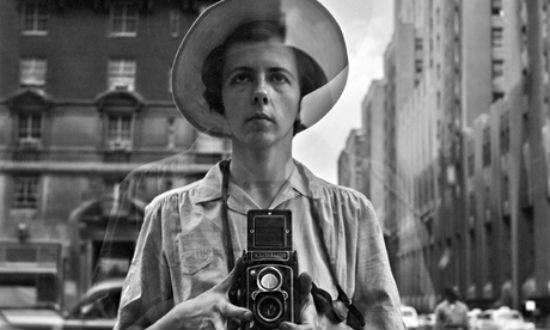Bold…mysterious…private…eccentric.
This film starts with words – words that are worlds – which define the French-born American street photographer of the 1950s through 1980s, the enigmatic Vivian Maier.
In the winter of 2007, writer and director of this documentary, John Maloof, came across a box of negatives at a Chicago flea market. Having grown up ferretting through junk sales, Maloof was not deterred by the fact that ‘negatives have no value’.
He proved himself wrong.
The next six years have taken Maloof on a remarkable journey from Chicago to New York to provincial France and into the offices of some of America’s great photography historians.
Maloof described Maier early in the film as a ‘pack rat’. Now with near 90% of her archive documented, Maier is gaining posthumous respect for her work, ‘as one of America’s most accomplished and insightful street photographers’ (as described in the film’s promotional material), fitting within a renaissance of interest in the art of street photography.
The charm of this film is that it doesn’t just tell that story – rather you start to live it; the excitement of the next clue, the unexpected twists and turns, the empathy, the passion, the shock, the blackness.
Maloof teamed with producer Charlie Siskel to uncover the peculiarities of Vivian Maier; it is their first directorial work.
100,000 negatives
700 undeveloped colour rolls of film
200 undeveloped black and white rolls
Who was this photographer?
Maloof took that box home from that flea market and started to look at the images. Along with her subject, Maier took many photographs of herself, Rolleiflex twin-lens reflex camera a perpetual pendant around her neck.

While this film could have dwelt on the socio-ethnographic value of Maier’s images, rather it turns to those who knew Maier, everyday people who encountered a not-so-everyday photographer.
Was she really French?
Did she want to be recognised as an artist?
Would she have enjoyed celebrity had she shown her images in her time?
If that intrigue isn’t enough, there is a darker side to this film.
Maier was a career nanny for the affluent, which allowed her certain freedoms to take her photographs. Maloof rolls out a string of those children; one after another who describe levels of psychological abuse, being dragged in her wake to gritty city precincts, and memories of what she photographed. One even tells of Maier photographing their brother who was hit by a car, rather than comforting the child.
‘She didn’t fit in well’, said Maloof. ‘She was much more damaged than I thought.’
Maier was an obsessive-compulsive hoarder; obsessively private and obsessively anti-social. In some way, she becomes one of her subjects – a fringe dweller. And yet despite that she had this brilliance to frame on image and an instinct for human tragedy.
Maloof manages to balance those anecdotes and curiosities with a lightness and an uncompromised quest to tell a story; to reveal a truth. Maloof does not cast judgment with his film.
Finding Vivian Maier holds you through its entire 85 minutes. Is it our own ghoulish lust for voyeurism? A strange parallel, with Maier’s own drive to look at others?
You are hungry for the next revelation, and when you learn, in the first third of the film, that Maier was indeed dead it is almost an insignificant detail. This is no Hollywood ending. It is her legacy through these negatives; these images that drives this documentary and our watching; Maloof weaving the viewer into his hunt.
This film is presented incredibly simply; it’s beautifully structured without trying to be “arty” or too weighty as a documentary. And, yet, it remains very layered. There is no chronology here. You are ushered deeper and deeper into her personality through encounters and side-roads. Perhaps this is what keeps it fresh to watch.
Maloof keeps a level of mystery, which he slowly reveals like an armchair treasure hunt. It is enjoyable beyond the art-buff. It is not surprising that Maier’s images have become internationally celebrated at the hands of Maloof, and indeed this film is also being recognised at film festivals internationally.
And, while Maloof ‘picks a bone’ across this film that the hallowed halls of photographic museums and the curatorium continue to choose not to recognise Vivian Maier, his belief in her work has paid off. Her work is being sold and her story told.
This is a remarkable film about a remarkable artist – who is no longer in “the darK”, a dark place.
Rating: 5 out of 5 starsFinding Vivian Maier
Directors: John Maloof, Charlie Siskel
USA, 2013, 84 mins
Release date: 30 October (nationally)
Distributor: Vendetta Films
Rated: PG
Genre: Documentary
Official selection: Toronto Film Festival & Berlin Film Festival
Official Site: www.vivianmaier.com
For the first time in Australia, Vivian Maier’s images can be seen at the Centre for Contemporary Photography to coincide with the Melbourne Festival. For more on Crossing Paths with Vivian Maier, curated by Naomi Cass & Karra Ress, please visit Melbourne Festival.
Finding Vivian Maier will also be screened as a special release at the Australia Centre for the Moving Image (ACMI) to coincide with the exhibition as part of the Melbourne Festival.





